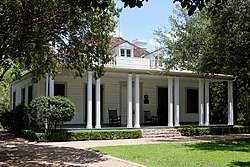French Legation, Texas
French Legation | |
 The French Legation now serves as a period museum and host to a variety of community events. | |
| Location | 802 San Marcos St. Austin, Texas, USA |
|---|---|
| Built | 1841 |
| NRHP reference No. | 69000213 |
| Added to NRHP | November 25, 1969 |
The French Legation is a historic legation building in east Austin, Texas, built in 1841 to represent the French government in the new Republic of Texas.
It is the oldest extant frame structure in Austin. The building and its surroundings were added to the National Register of Historic Places in 1969.
History
After Texas declared independence from Mexico in 1836, France was one of two countries (the other being the United States) to officially recognize Texas as an independent state. This was sealed on the September 25, 1839 with the Treaty of Amity, Navigation, and Commerce between the two countries. France subsequently assigned Monsieur Jean Pierre Isidore Alphonse Dubois, a secretary in the French Legation in Washington, to be the new chargé d'affaires of his majesty Louis Philippe, the King of the French to the Republic of Texas. Dubois was to remain in Austin to maintain an official presence there. When the common-born Dubois arrived in September, 1840, he had added de Saligny to his name and introduced himself to the citizens of Austin as a count, a Papal honor, unrelated to his role as a diplomat.
The legation structure was completed in 1840-1841, approximately a half-mile east of the city center, and was a truly lavish abode compared to the standards of Austin at that time (temporary log structures were the norm). Dubois gave multi-course dinner parties in the cabin he rented down town as his mansion was built and worked with legislators to bring French settlers to Texas. Count de Saligny's stay in Austin was not, however, without conflict. Dubois and the inn-keeper Richard Bullock were famously enemies. His conflict with Austinites even came to blows in the so-called 1841 Pig War, when his butler killed several havoc-wreaking pigs belonging to Bullock and was in turn assaulted by Bullock.
After the young nation's capital was temporarily moved to Washington-on-the-Brazos, Texas, in 1842 during the Archive War, the legation buildings were abandoned and deteriorated rapidly. The French Government recalled Count de Saligny in 1846, when the Republic of Texas ceased to be a country.
The mansion was later occupied by John Mary Odin, first Bishop of the Diocese of Galveston, and then Moseley Baker, hero of the Texas Revolution, in 1847. Dr. Joseph W. Robertson bought the estate from Baker and generations of his family resided there until 1940. The State of Texas purchased the site from Robertson's heirs in 1945. At that time, the state placed the property in the custody of the Daughters of the Republic of Texas (DRT), who established the French Legation Museum in 1949. The DRT restored the legation building and grounds and opened the site to the public on April 5, 1956.[1]
See also
References
- ^ Hafertepe, Kenneth. "French Legation". Handbook of Texas Online. Retrieved Nov 21, 2011.
External links
- National Register of Historic Places in Austin, Texas
- French-American culture in Texas
- Government buildings completed in 1841
- Museums in Austin, Texas
- Historic house museums in Texas
- History of Austin, Texas
- Foreign relations of the Republic of Texas
- Diplomatic missions of France
- 1841 establishments in Texas
- Defunct diplomatic missions in the United States

